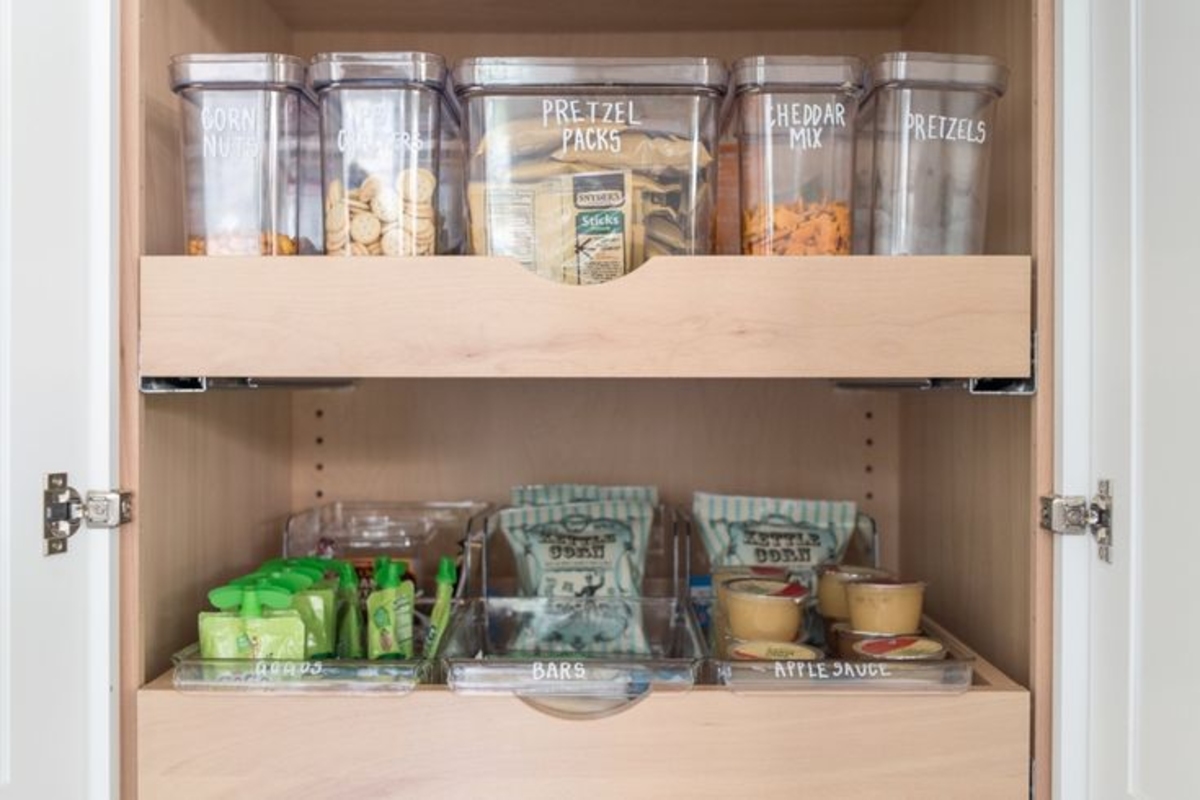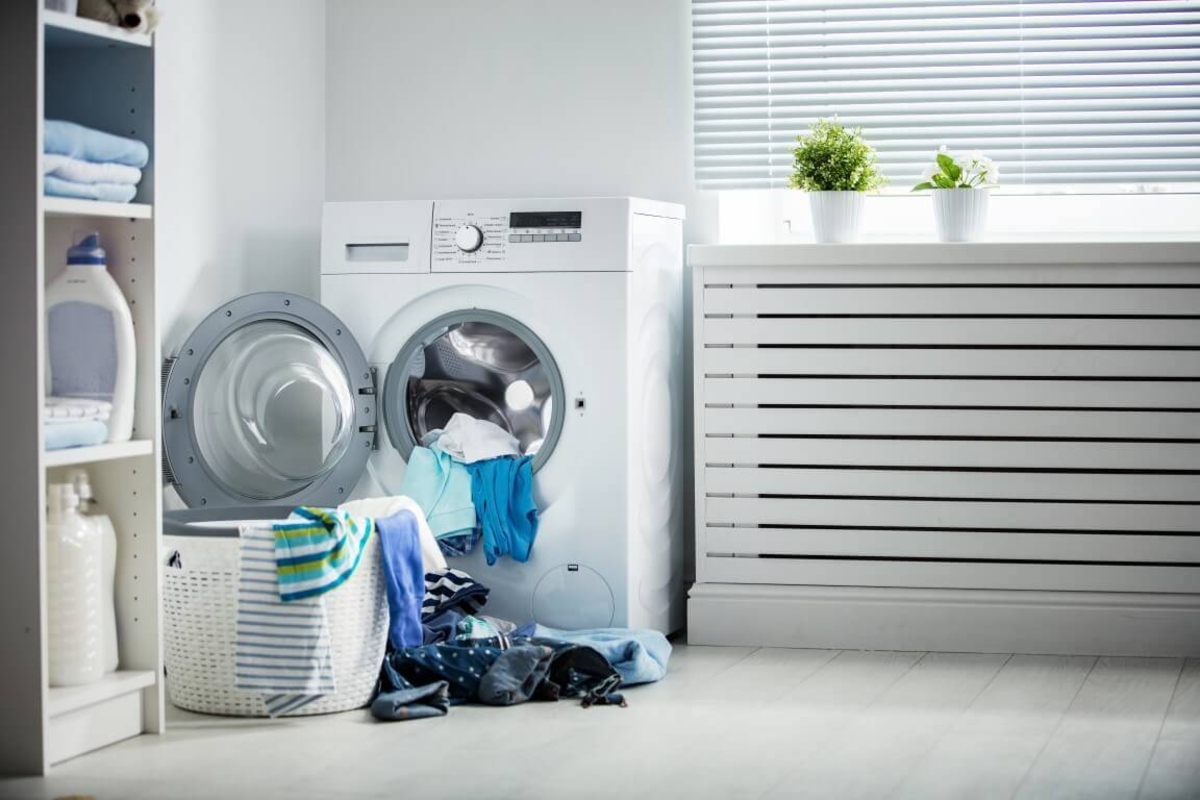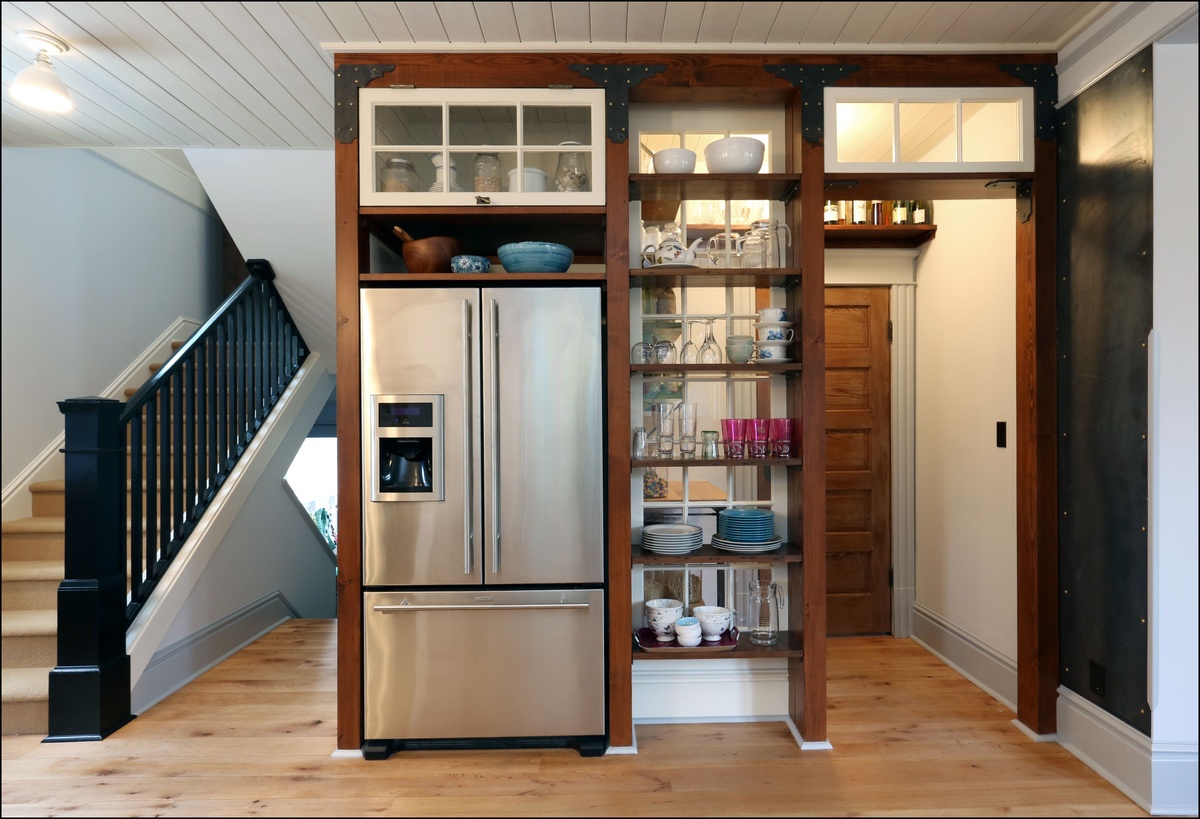Home>Interior Design>Small Pantry Organizing Mistakes: 7 Common Mishaps To Avoid


Interior Design
Small Pantry Organizing Mistakes: 7 Common Mishaps To Avoid
Modified: April 22, 2024
Avoid these 7 common small pantry organizing mistakes to maximize your interior design and efficiently utilize your space.
(Many of the links in this article redirect to a specific reviewed product. Your purchase of these products through affiliate links helps to generate commission for Storables.com, at no extra cost. Learn more)
Small Pantry Organizing Mistakes: 7 Common Mishaps to Avoid
When it comes to organizing your pantry, a small mistake can lead to big frustrations. Clutter, wasted space, and difficulty finding items can quickly turn a once-functional pantry into a chaotic mess. To help you avoid these common pitfalls, here are seven small pantry organizing mistakes to steer clear of:
1. Not Utilizing Vertical Space Effectively
One of the biggest mistakes people make when organizing their pantry is not using the vertical space to its fullest potential. Don’t just rely on shelves; consider installing hooks, racks, or door organizers to hang items like aprons, measuring cups, or spices. This will free up valuable shelf space for storing larger items.
2. Overcrowding Your Pantry
It may be tempting to cram everything into your pantry, but overcrowding can make it difficult to find what you need. Be sure to declutter regularly and create designated spaces for different categories of items. Use clear bins or containers to help keep items organized and easily visible.
3. Lack of Proper Categorization
Without proper categorization, your pantry can quickly become a mishmash of food items. Avoid this by grouping similar items together, such as canned goods, baking supplies, snacks, and so on. This makes it easier to locate specific items and helps prevent duplicate purchases.
4. Neglecting Expiration Dates
Failing to keep track of expiration dates is a common mistake that can lead to wasted food and money. Regularly check the dates on perishable items and prioritize using them before they expire. Consider using clear storage containers to store bulk items, so you can easily see when they need to be replenished.
5. Poor Container Choice
Using the wrong containers can contribute to disorganization in your pantry. Avoid flimsy or mismatched containers that take up unnecessary space. Opt for stackable and airtight containers to maximize shelf space and keep food fresh for longer.
6. Ignoring Accessibility
Accessibility is key when it comes to maintaining an organized pantry. Arrange items in a way that makes them easily accessible, with frequently used items at eye level or within reach. Keep less frequently used items on higher or lower shelves.
7. Failure to Maintain Organization
Organizing your pantry is not a one-time task; it requires ongoing maintenance. Make it a habit to regularly declutter, clean, and reorganize your pantry to ensure it stays functional. Set aside a few minutes each week to tidy up and make any necessary adjustments.
By avoiding these small pantry organizing mistakes, you can create a functional and efficient space that makes meal prep and grocery shopping a breeze. Take the time to assess your pantry and implement these tips, and you’ll be well on your way to a clutter-free and organized space. Happy organizing!
Key Takeaways:
- Maximize vertical space in your pantry by using hooks, racks, and stackable storage. Clear containers and shelf dividers help keep items organized and easily accessible, creating an efficient and visually pleasing pantry.
- Avoid overcrowding by decluttering, creating zones, and using clear containers. Group similar items together and consider outsourcing storage for a well-organized and efficient pantry.
Not Utilizing Vertical Space Effectively
When it comes to organizing your pantry, the key is to maximize every inch of available space. While shelves are commonly used for storage, many people overlook the potential of vertical space. By not utilizing vertical space effectively, you may find yourself struggling with a cluttered and disorganized pantry. Here are some tips to help you optimize vertical space and make the most of your pantry organization:
1. Install Hooks and Racks: Instead of relying solely on shelves, consider installing hooks and racks to hang items such as aprons, measuring cups, or spices. This can free up valuable shelf space for storing larger items and create a more efficient and visually pleasing pantry.
2. Utilize the Inside of Doors: The inside of pantry doors often goes unused, but it can be a great opportunity to add storage. Install door organizer racks or adhesive hooks to hang smaller items like measuring spoons or oven mitts. This way, you can keep frequently used items within easy reach and declutter your shelves.
3. Use Stackable Storage: Invest in stackable storage containers or bins to make better use of vertical space. These containers allow you to stack items on top of each other, making more efficient use of the space from floor to ceiling.
4. Consider Shelf Dividers: Shelf dividers are a useful tool to separate and organize items. They can create compartments within your pantry shelves to keep different types of items separate. This makes it easier to locate and retrieve specific items without causing mess or disarray.
5. Optimize Shelf Heights: Adjust the heights of your shelves to accommodate different sizes of items. By having adjustable shelves, you can create customized storage areas, making it easier to fit items of varying heights and reducing wasted space.
6. Utilize Tension Rods: Tension rods are not just for hanging curtains. They can also be used in your pantry to create additional storage options. Install tension rods vertically to create dividers for cutting boards, baking trays, or pot lids. This can help keep these items upright and organized while also maximizing vertical space.
7. Use Clear Containers: Opt for transparent containers when storing dry goods like cereal, pasta, or snacks. Clear containers allow you to see the contents at a glance, making it easier to identify what you need and preventing the frustration of searching through cluttered shelves.
8. Think Upwards: Don’t forget about the space above the pantry shelves. Consider installing additional shelving or using hanging baskets to provide even more storage options. This can be a great place to store infrequently used items or bulk purchases.
By implementing these strategies, you can effectively utilize vertical space in your pantry and create a more organized and efficient storage system. Remember to regularly declutter and reassess your pantry to ensure that it remains functional and clutter-free. Embracing vertical space will not only help you make the most of your pantry organization but also save you time and reduce frustration when searching for ingredients or supplies.
Overcrowding Your Pantry
An overcrowded pantry is a common mistake that can lead to frustration and inefficiency. When there is not enough space to properly store and organize your items, it becomes difficult to find what you need and maintain an orderly pantry. To avoid overcrowding and make the most of your pantry space, consider the following tips:
1. Declutter Regularly: Start by decluttering your pantry and getting rid of items that are expired, stale, or no longer needed. This will free up space and make it easier to organize the remaining items.
2. Create Zones: Divide your pantry into different zones based on categories such as canned goods, snacks, baking supplies, and spices. This will help you visually compartmentalize your items and make it easier to find what you need.
3. Use Vertical Storage: Maximize your vertical space by utilizing stacking shelves or shelf risers. These can help you create additional layers of storage within your pantry, allowing you to fit more items without crowding the shelves.
4. Group Similar Items Together: Arrange items within each zone by grouping similar items together. For example, keep all your pasta and grains in one section, and all your canned vegetables in another. This not only makes it easier to find specific items, but also helps to prevent duplicate purchases.
5. Utilize Clear Containers: Transfer items like cereal, pasta, or nuts into clear, airtight containers. Not only does this help to keep your items fresh and protected, but it also allows you to easily see how much of each item you have left.
6. Consider Outsourcing Storage: If your pantry is still overcrowded despite your best efforts, consider storing non-perishable items in another location. This could be a basement, garage, or even a nearby closet. Keep a small inventory of frequently used items in your pantry and replenish as needed.
7. Avoid Impulse Buys: Be mindful of your shopping habits and avoid impulse buys. Only purchase items that you know you will use and have space for in your pantry. This will help prevent overcrowding and ensure that you are making the most of your available storage space.
Remember, an organized and clutter-free pantry not only makes it easier to find items, but it can also save you time and money. By implementing these tips, you can create a well-organized and efficient pantry that meets your needs and helps simplify your daily meal preparations. Regularly reassess and declutter, and consider reorganizing as your needs change over time. With a little effort and strategic planning, you can create a pantry that is both functional and visually appealing!
Lack of Proper Categorization
Proper categorization is essential for maintaining an organized and functional pantry. Without clear categories, it can be challenging to locate specific items and maintain order within your pantry. If you find yourself struggling to keep your pantry organized, here are some tips to help you establish a system of proper categorization:
1. Assess Your Pantry: Start by taking inventory of the items in your pantry. This will give you a clear understanding of what you have and allow you to identify common categories that can be established.
2. Group Similar Items: Begin organizing your pantry by grouping similar items together. For example, create separate sections for canned goods, dry goods, snacks, spices, baking ingredients, and so on. This will make it easier to find specific items and prevent items from being scattered throughout the pantry.
3. Use Labels: Invest in labels or label makers to clearly mark the different categories in your pantry. Use easy-to-read and descriptive labels that can be easily seen at a glance. Labels not only help you identify where items belong, but they also help other family members or guests locate items when needed.
4. Consider Zones: Within each category, create smaller zones to further organize and separate items. For example, within your canned goods section, you can create zones for vegetables, soups, beans, and so on. This will help ensure that items within each category are easily accessible and identifiable.
5. Arrange Items Strategically: When categorizing your pantry, consider how frequently you use certain items. Place frequently used items at eye level or within easy reach, while less frequently used items can be stored on higher or lower shelves. This will maximize accessibility and ensure that items you use regularly are within arm’s reach.
6. Regularly Reorganize: As your pantry inventory changes and evolves, periodically reorganize your categorization system to accommodate new items or changes in your needs. This will help keep your pantry organized and functioning optimally.
7. Involve the Whole Family: Make sure everyone in the household is on board with the categorization system. Communicate the organization plan and encourage family members to put items back in their designated places. By involving the whole family, you can create a system that everyone understands and follows, reducing the chances of items becoming misplaced or disorganized.
Proper categorization not only helps you find items quickly and easily, but it also streamlines your meal planning and grocery shopping. By establishing clear categories and maintaining an organized pantry, you can save time, reduce food waste, and create a more efficient cooking experience. Embrace the power of categorization and enjoy the benefits of a well-organized pantry!
Neglecting Expiration Dates
Neglecting expiration dates is a common mistake that can lead to wasted food, potential health risks, and unnecessary spending. It’s important to pay attention to expiration dates and prioritize using items before they expire. To avoid this mistake and ensure the freshness and safety of your pantry items, consider the following tips:
1. Regularly Check Expiration Dates: Make it a habit to check the expiration dates on your pantry items regularly. Take a few minutes every month to go through your pantry and discard any items that have expired or are close to expiration.
2. Follow the “First In, First Out” Rule: When restocking your pantry or adding new items, practice the “first in, first out” rule. Place newer items behind older ones, ensuring that the older items are used first. This helps to prevent items from sitting in your pantry for too long and ensures that you consume them before they expire.
3. Organize by Expiration Date: Arrange your pantry items in a way that makes it easy to identify and prioritize items that are nearing their expiration dates. Consider grouping items based on categories and then within each category, arrange them by expiration date, with the items nearest to expiration at the front.
4. Rotate Stock: When you bring new items into your pantry, move older items to the front so that they are more visible and easily accessible. This method encourages the use of items before they expire and reduces the chance of forgetting about items hidden in the back of your pantry.
5. Use Clear Storage Containers: Transferring dry goods such as flour, sugar, or rice into clear, airtight containers can help you see the contents and expiration dates more easily. This allows you to monitor the freshness of the items and prevents you from accidentally using expired ingredients.
6. Donate or Share Excess Food: If you realize you have items in your pantry that you won’t be able to consume before they expire, consider donating them to a local food bank or sharing them with friends or family members. This not only avoids food waste but also ensures that others can benefit from the items before they go bad.
7. Incorporate Expiring Items into Meal Planning: If you have items in your pantry that are close to their expiration dates, incorporate them into your meal planning. Look up recipes that specifically call for those ingredients, allowing you to utilize them before they become inedible.
By being mindful of expiration dates, you can reduce food waste, save money, and maintain a healthier pantry. Incorporating these practices into your pantry organization routine will help you stay on top of expiration dates and make the most of the items you purchase. Remember, safety and freshness should always be prioritized, so never hesitate to discard items that have passed their expiration dates.
Poor Container Choice
Choosing the right containers for your pantry is crucial for maintaining an organized and efficient space. Poor container choice can lead to wasted space, difficulty in finding items, and even spoilage of food. To optimize your pantry organization, consider the following tips for selecting the right containers:
1. Assess Your Space: Before purchasing containers, assess the size and layout of your pantry. Take measurements of shelves and consider the depth and height limitations. This will help you determine the appropriate sizes and types of containers that will fit well in your pantry.
2. Consider Stackability: Opt for containers that are designed to stack well, maximizing vertical space and preventing wasted shelf space. Stackable containers allow you to efficiently utilize the height of your pantry shelves while keeping items organized and accessible.
3. Use Clear Containers: Transparent containers are a great choice for storing pantry items. They allow you to see the contents at a glance, making it easier to locate specific items and monitor the quantity of ingredients you have on hand. Clear containers also add a clean and visually appealing look to your pantry.
4. Choose Airtight Containers: When storing dry goods such as flour, sugar, or cereal, opt for airtight containers. These help to preserve the freshness and flavor of your ingredients by keeping out moisture, pests, and air. Airtight containers also prevent ingredients from spilling and creating a mess in your pantry.
5. Consider Container Shape: Think about the shape and design of containers to maximize space and make them easier to stack and store. Rectangular or square-shaped containers are usually more space-efficient than round ones since they fully utilize the corners and edges of your pantry shelves.
6. Label Your Containers: Once you have chosen the appropriate containers, invest in labeling them. Clearly labeling your containers not only adds a decorative touch to your pantry but also helps you quickly identify and locate specific items. Use labels that are easy to read and consider using uniform labels for a cohesive look.
7. Evaluate Durability and Maintenance: Consider the material and durability of the containers you choose. Look for containers that are easy to clean, dishwasher-safe, and resistant to stains or odors. This will make it easier to maintain your pantry’s cleanliness and ensure the longevity of your containers.
8. Repurpose Containers: Don’t feel pressured to buy new containers for your pantry organization. Consider repurposing glass jars or plastic containers that you already have. This is not only an environmentally-friendly option but can also add a unique touch to your pantry’s aesthetic.
By selecting the right containers for your pantry, you can create a well-organized and visually appealing space that maximizes storage and promotes efficiency. Remember to assess your space, prioritize functionality, and invest in clear, stackable, and airtight containers. With the right containers in place, you’ll be able to maintain a clutter-free and easily accessible pantry.
Ignoring Accessibility
One of the most common mistakes in pantry organization is ignoring accessibility. A well-organized pantry is not only about making items look neat on the shelves but also ensuring that you can easily access what you need. Ignoring accessibility can lead to frustration and inefficient meal preparation. To avoid this mistake and create a pantry that is both organized and accessible, consider the following tips:
1. Arrange Items by Frequency of Use: When organizing your pantry, consider how often you use certain items. Place frequently used items at eye level or within easy reach. This will save you time and effort when you are trying to find ingredients on a hectic weekday evening.
2. Organize According to Zones: Create zones in your pantry based on different categories such as canned goods, baking supplies, snacks, or spices. Within each zone, arrange items so that those used most often are the easiest to access. This way, you won’t have to shuffle through multiple items to find what you need.
3. Optimize Shelf Height: Adjust the height of your pantry shelves to accommodate different sizes of items. This will help you make the most of the available space and ensure that items are easily accessible. Consider using adjustable shelving units if possible.
4. Use Drawer Baskets or Pull-Out Shelves: Install pull-out shelves or drawer baskets in your pantry to improve accessibility. These allow you to easily access items stored at the back of the pantry without having to move everything in front. You’ll be able to see and reach items without straining or causing any disarray.
5. Utilize Step Stools or Reach Extenders: If you have high shelves in your pantry, make sure you have a step stool or reach extender on hand. This will allow you to access items stored in higher areas without the risk of injury. Having the right tools will make reaching for items on higher shelves easier and safer.
6. Implement Clear Storage Containers: Using clear storage containers for smaller items like spices, snacks, or baking ingredients can make it easier to see what is inside and quickly find what you need. Transparent containers eliminate the guesswork and save you from the hassle of opening multiple containers to find that one spice you are looking for.
7. Label Everything Clearly: Labeling your containers and shelves is essential for ease of access. Use clear and legible labels that can be easily read, even from a distance. This will ensure that you can quickly locate items and maintain the organization of your pantry.
8. Regularly Rearrange and Declutter: Regularly reassess the accessibility of your pantry and make necessary adjustments as your needs change. Take the time to rearrange items, declutter expired or unused products, and optimize shelf space to ensure maximum accessibility.
By prioritizing accessibility in your pantry organization, you will save time and effort in the kitchen. Whether you implement adjustable shelving, install pull-out shelves, or simply reorganize items by frequency of use, creating an accessible pantry will make your cooking experience much more efficient and enjoyable.
Failure to Maintain Organization
One of the most common mistakes in pantry organization is the failure to maintain it over time. It’s not enough to organize your pantry once and assume it will stay that way indefinitely. Without regular maintenance, your pantry can quickly become cluttered and disorganized, making it difficult to find items and increasing the chances of food waste. To avoid this mistake and keep your pantry organized, here are some tips for maintaining organization:
1. Schedule Regular Decluttering Sessions: Set a schedule for regular decluttering sessions in your pantry. Plan to do this at least once a month or as needed. Take the time to go through your pantry, check expiration dates, discard any expired or unwanted items, and reorganize if necessary.
2. Put Items Back in Their Designated Spots: Make it a habit to put items back in their designated spots after use. Avoid the temptation of leaving things on the counter or out of place. Return items to their proper shelves or containers immediately to maintain the organization and minimize clutter.
3. Use a First-In, First-Out System: When adding new items to your pantry, remember to arrange them according to the “first-in, first-out” principle. Place newer purchases behind older ones to ensure that older items are used first. This helps prevent items from languishing in your pantry and minimizes wasted food.
4. Keep Like Items Together: Continuously monitor your pantry to ensure that like items are grouped together. Regularly rearrange items as needed to maintain a logical and efficient organization system. This will make it easier to find what you need and maintain order in your pantry.
5. Refresh Your Labels: Over time, labels may become worn or illegible. Plan to refresh your labels periodically to ensure that they remain clear and easy to read. Consider investing in label makers or using chalkboard labels that can be easily updated as needed.
6. Inspect Containers and Storage Solutions: Regularly inspect your storage containers, bins, and shelves to ensure they are in good condition. Replace any damaged containers or storage solutions that are no longer functional. This will help you maintain a well-organized and visually appealing pantry.
7. Involve the Whole Family: Engage your family members in maintaining pantry organization. Encourage everyone to follow the organizational system you’ve established and communicate the importance of maintaining order. By working together, you can ensure that your pantry stays organized for everyone’s benefit.
8. Reevaluate and Adjust as Needed: As your pantry needs and lifestyle change, be open to reevaluating and adjusting your organization system. Consider whether certain items need to be relocated or if new storage solutions need to be implemented. Your pantry organization should be flexible and adaptable to best serve your unique needs.
By incorporating these maintenance tips into your pantry organization routine, you can sustain an orderly and efficient pantry. Regular decluttering, keeping items in their designated spots, and periodic reassessment will help you enjoy the benefits of an organized pantry for longer periods, making meal preparation and grocery shopping much more streamlined and enjoyable.
Frequently Asked Questions about Small Pantry Organizing Mistakes: 7 Common Mishaps To Avoid
Was this page helpful?
At Storables.com, we guarantee accurate and reliable information. Our content, validated by Expert Board Contributors, is crafted following stringent Editorial Policies. We're committed to providing you with well-researched, expert-backed insights for all your informational needs.













0 thoughts on “Small Pantry Organizing Mistakes: 7 Common Mishaps To Avoid”